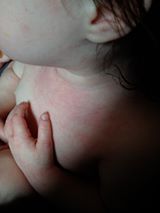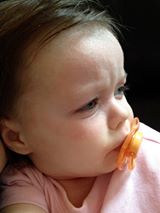Introducing foods to your baby can be overwhelming! It can be scary introducing foods that are a part of the top allergens. As a parent who has dealt with allergies in many different ways, I am here to lay it out for you. I want to give you the confidence to introduce these foods, know how to recognize allergic reactions, and how to manage allergies. I will also give you some great resources for more information around food introduction and allergies!
Children can have an allergic reaction to ANY food, but the most common allergens include:
- Milk
- Egg
- Peanut
- Tree nuts
- Soy
- Wheat
- Fish
- Shellfish
- Sesame


- Current research suggests the early introduction of peanuts. Giving them to children around 6 months of age (and not before 4 months). Other allergenic foods are recommended at 6 months as well (according to the Canadian Paediatric Society). They can be introduced in baby-led weaning (BLW) appropriate servings. This is believed to help those at a high risk of allergies (children who have severe eczema or predetermined egg allergies) to build a tolerance to these foods and prevent allergies. If your child IS at high risk of having food allergies, or you already suspect allergies before introducing foods it is very important to speak to your doctor and they can give you guidance on introducing these foods in a way that is appropriate for your child.
- When introducing peanuts (or other common allergens) to your child you will want to ensure your child is developmentally ready for solid foods. This includes having the ability to sit up and have good neck support (this is necessary to prevent choking and give baby the ability to spit out food), an interest in food (reaching for your plate, etc), and the ability to suck and chew on toys or other items.
- Choose a day when you will be at home with your child and they are well (not sick). Give your child another food that they have already had without issue. Then prepare the food you’re introducing in a safe way, ie. peanut butter can be mixed with warm water to dissolve it (so it is less thick and sticky) and then be mixed into another food or served as is. This can be done the same way for other nut butters as well. Dairy should be introduced in the form of cheese (shredded or small strips) or yogurt (whole milk isn’t recommended until babies are older, and is still not necessary if the child is continuing to breastfeed). The other top allergens can be introduced in whatever fashion you would prepare them for yourselves (ensuring eggs and fish are well cooked) and served in the appropriate BLW sizes.
- Once you’ve introduced these foods (especially peanuts) its important to serve them on a regular basis (2-3 times per week).
- It is unlikely that your child will have a reaction, and even more unlikely that a severe reaction will happen on the first introduction. You should watch for symptoms up to two hours after exposure. Mild symptoms may include redness around the mouth, or a few hives (you will want to follow up with your care provider on how to manage this). More extreme reactions that require immediate medical attention (call 911) include vomiting, persistent coughing, wheezing, swelling, difficulty breathing or change in skin colour (full body redness or they become pale/blue).
- What happens if your child has an anaphylactic (extreme) reaction and you discover they are allergic to a certain food?
- Ensure that you reach out for the proper medical support. See your GP and get a referral to a pediatric allergist. They can help you navigate the world of allergies. They will provide you with a prescription for epinephrine in a way that is appropriate for your child (Epi-Pen JR, Auvi-Q, etc). They will also provide you with the right resources to train you on how to use your epinephrine, how to store it, and when to renew it. Another thing that your care provider will be able to guide you on is allergy treatments. Currently, there are multiple options to help manage specific food allergies including oral immunotherapy, patches, and sublingual immunotherapy.
- Getting the chance to educate yourself, your family and anyone caring for your food allergic child are essential as well. Understanding food allergies, reactions, and being prepared will help you build confidence in managing these allergies. Reading labels and understanding of cross contamination risks will become a new language for you! Finding other parents who are in a similar situation is a wonderful way to find support. Living with allergies and managing a life-threatening condition for your child is heavy stuff. Finding people who have walked this line and have experience can help make it just a touch easier.
- Understand that although your life will change, and you will be handed a very big responsibility life is not over as you know it. There are many safe ways you can continue to enjoy the activities, events, and foods of your past with your food allergic child. There are currently so many safe alternatives for almost every food imaginable. Figuring out what works best for your family will take time, patience, and lots of advocating on behalf of your child. But you are the one for the job!
- If someone you know has a child with food allergies you can support them by:
- – Not offering their child food (unless given to you by the parents themselves).
- -Ensuring your own children don’t eat their friend’s allergens when together (when possible). And taking all the proper precautions to keep their friend safe, keeping their food contained, washing their hands after eating, and not offering their food to friends.
- – Creating an environment that is safe for the child when you get together. If you aren’t sure if your home would be safe for a play date, ask the parent what would be best for them? Do they prefer to host or go to a park?
- -When giving gifts/goody bags/trick or treat items etc offer non-food items or treat that the parents have explicitly told you are safe for that child.
- -Understand if the family chooses to sit out certain activities or events due to their child’s allergies. Some places are overly saturated with foods and risky situations for children with multiple food allergies. Be supportive of this.
- Below are some resources that can help with the introduction:
- Here is a great FAQ post from Food Allergy Canada that goes into more detail on a lot of this information.
- https://foodallergycanada.ca/wp-content/uploads/FAQs-for-early-infant-feeding-guidelines-2.pdf
- Here is a webinar that gives lots of great information and how-to on introducing peanut butter (and other foods!) to your baby.
- https://youtu.be/p-8J7TNp-ao
- If your child has food allergies and you are looking for a local community to join, this group is for you!
- https://www.facebook.com/groups/vancouveranaphylaxis/
Written By Katie Walsh- Early Childhood Educator, Doula and allergy mom